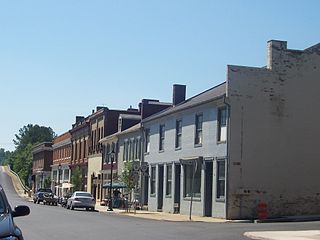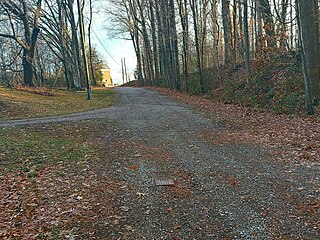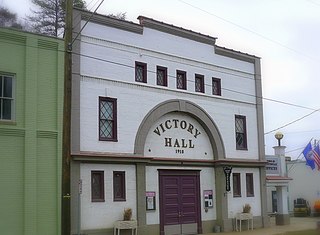Related Research Articles

Fluvanna County is a county located in the Piedmont region of the Commonwealth of Virginia, United States. As of the 2020 census, the population was 27,249. Its county seat is Palmyra, while the most populous community is the census designated place of Lake Monticello.

Charlottesville, colloquially known as C'ville, is an independent city in Virginia, United States. It is the seat of government of Albemarle County, which surrounds the city, though the two are separate legal entities. It is named after Queen Charlotte. At the 2020 census, the city's population was 46,553. The Bureau of Economic Analysis combines the City of Charlottesville with Albemarle County for statistical purposes, bringing its population to approximately 160,000. Charlottesville is the heart of the Charlottesville metropolitan area, which includes Albemarle, Fluvanna, Greene, and Nelson counties.

Albemarle County is a United States county located in the Piedmont region of the Commonwealth of Virginia. Its county seat is Charlottesville, which is an independent city entirely surrounded by the county. Albemarle County is part of the Charlottesville Metropolitan Statistical Area. As of the 2020 census, the population was 112,395.

Scottsville is a town in Albemarle and Fluvanna counties in the U.S. state of Virginia. The population was 522 at the 2020 census. It is part of the Charlottesville Metropolitan Statistical Area.
Randolph Jefferson was the younger brother of Thomas Jefferson, the only male sibling to survive infancy. He was a planter and owner of the Snowden plantation that he inherited from his father. He served the local militia for about ten years, making captain of the local militia in 1794. He also served during the Revolutionary War.

The Southwest Mountains of Virginia are a mountain range centered on Charlottesville, parallel to and geologically associated with the Blue Ridge Mountains, which lie about 30 miles (50 km) to the west. The range is breached by the Rivanna River between Monticello and Pantops Mountain. Some of the more prominent peaks include Carters Mountain, Fan Mountain, Brush Mountain, Peters Mountain, Walton's Mountain, and Hightop Mountain.

Earl Henry Hamner Jr. was an American television writer and producer, best known for his work in the 1970s and 1980s as the creator of two long-running series, The Waltons and Falcon Crest. As a novelist, he is best known for Spencer's Mountain, which was inspired by his own childhood and formed the basis for both the film of the same name and the television series The Waltons, for which he provided voice-over narration. at the beginning of most episodes to set the scene and provide context and occasionally at the end of the program.

Wilson Cary Nicholas was an American politician who served in the U.S. Senate from 1799 to 1804 and was the 19th Governor of Virginia from 1814 to 1816.
The Virginia Department of Transportation (VDOT) is the agency of the state government responsible for transportation in the state of Virginia in the United States. VDOT is headquartered at the Virginia Department of Highways Building in downtown Richmond. VDOT is responsible for building, maintaining, and operating the roads, bridges, and tunnels in the commonwealth. It is overseen by the Commonwealth Transportation Board, which has the power to fund airports, seaports, rail, and public transportation.

The Jamestown Ferry is a free automobile and bus ferry service across a navigable portion of the James River in Virginia. It carries State Route 31, connecting Jamestown in James City County with Scotland Wharf in Surry County.

State Route 6 is a primary state highway in the U.S. state of Virginia. Known for most of its length as River Road, the state highway runs 102.26 miles (164.57 km) from U.S. Route 250 in Afton east to SR 161 in Richmond. SR 6 is one of the main highways of mountainous Nelson County, where the highway runs north–south from its beginning to US 29. From Scottsville to Richmond, the state highway parallels the James River. SR 6 is a major suburban highway through southwestern Henrico County and the main street of Richmond's West End.

Transportation in the Commonwealth of Virginia is by land, sea and air. Virginia's extensive network of highways and railroads were developed and built over a period almost 400 years, beginning almost immediately after the founding of Jamestown in 1607, and often incorporating old established trails of the Native Americans.

Buildings, sites, districts, and objects in Virginia listed on the National Register of Historic Places:

State Route 20 is a primary state highway in the U.S. state of Virginia. The state highway runs 89.79 miles (144.50 km) from U.S. Route 15 in Dillwyn north to SR 3 in Wilderness. SR 20 is a C-shaped route that connects Charlottesville with Farmville in Southside Virginia. The state highway also links Charlottesville to Fredericksburg by way of Orange County, within which SR 20 is the main east–west highway and intersects US 15 again in the county seat of Orange.

State Route 53 is a primary state highway in the U.S. state of Virginia. Known as Thomas Jefferson Parkway, the state highway runs 18.32 miles (29.48 km) from SR 20 near Charlottesville east to U.S. Route 15 in Palmyra. SR 53 connects the county seats of Albemarle and Fluvanna counties. The state highway also provides access to the community of Lake Monticello and Monticello, the estate of Thomas Jefferson. The route of SR 53 became a state highway in 1930; the highway receives its present designation in 1947.

Batesville is an unincorporated community in Albemarle County, Virginia, United States. Its elevation is 620 feet (190 m).
Howardsville is an unincorporated community in Albemarle County, Virginia.

Three Notch'd Road was a colonial-era major east-west route across central Virginia. It is believed to have taken its name from a distinctive marking of three notches cut into trees to blaze the trail. By the 1730s, the trail extended from the vicinity of the fall line of the James River at the future site of Richmond westerly to the Shenandoah Valley, crossing the Blue Ridge Mountains at Jarmans Gap. In modern times, a large portion of U.S. Route 250 in Virginia follows the historic path of the Three Notch'd Road, as does nearby Interstate 64.

Christ Church Glendower is the oldest of the historic Episcopal church buildings in St. Anne's Parish, Albemarle County, Virginia near Scottsville. Christ Church Glendower is located in Keene, built of brick in 1831 in the Roman Revival style. It features a full Doric order entablature with pediments at each end containing lunette windows, and is surrounded by a contributing cemetery. The remaining two historic churches in St. Anne's parish are also discussed below.

Scottsville Historic District is a national historic district located at Scottsville, Albemarle County and Fluvanna County, Virginia. The district encompasses 153 contributing buildings, 1 contributing site, and 4 contributing structures in the town of Scottsville. The district includes commercial, residential, religious, factory and warehouse buildings in a variety of popular architectural styles including Federal, Georgian, Greek Revival, Gothic Revival, Italianate, Queen Anne, Prairie, Colonial Revival, and Craftsman. Notable buildings include Scottsville High School (1920), Riverview (1817), Chester (1847), Belle Haven, Oakwood, Herndon House (1800), The Tavern (mid-1700s), Scottsville Presbyterian Church (1832), Disciples Church (1846), Coleman's Store (1914), and the Fore House (1732). Located in the district and separately listed are Cliffside and Mount Walla.
References
- ↑ VDOT FINALIZES SERVICE AREA PROPOSALS Archived 2009-05-25 at the Wayback Machine , Press release, VDOT, May 20, 2009 retrieved 12 Jul 2009.
- ↑ Board of Supervisors Approves Hatton Ferry Funding Press release, Albemarle County, July 1, 2009, retrieved 12 July 2009.
- ↑ Historical Society hit with Hatton tab, Hawes Spencer, The Hook, 12 July 2009.
- ↑ Historical Society Votes to Close Hatton Ferry , January 21, 2025 retrieved 24 Jan 2025.